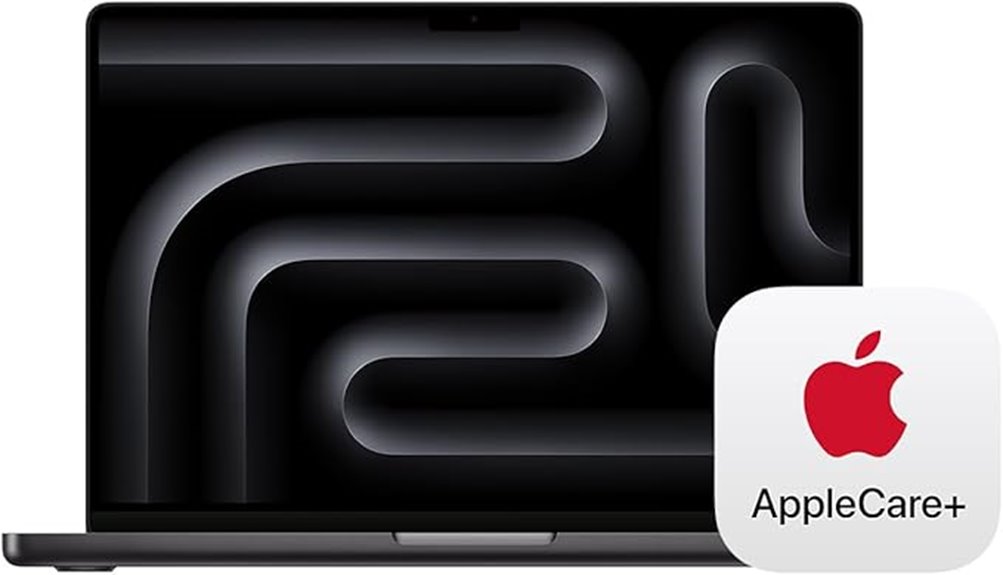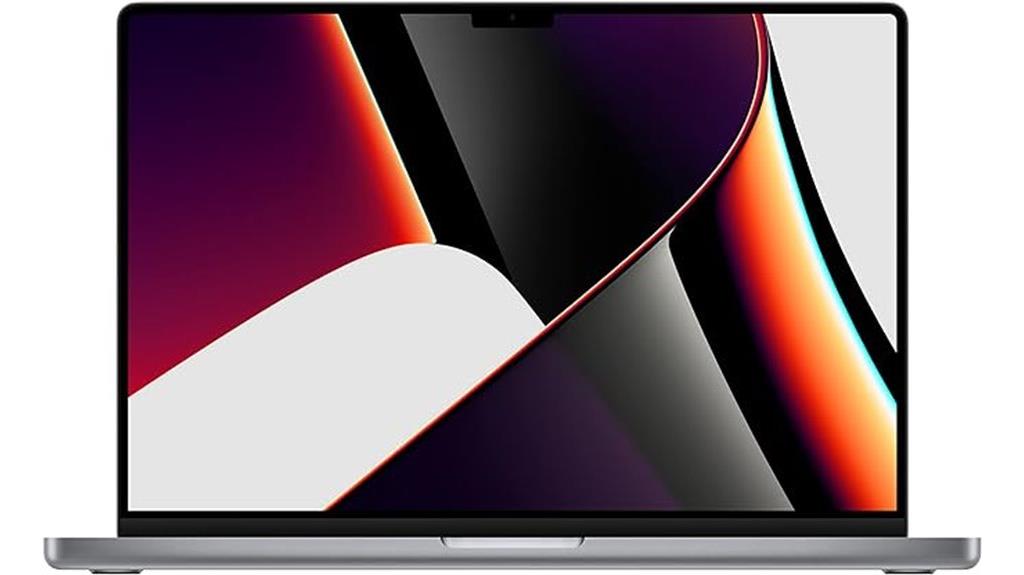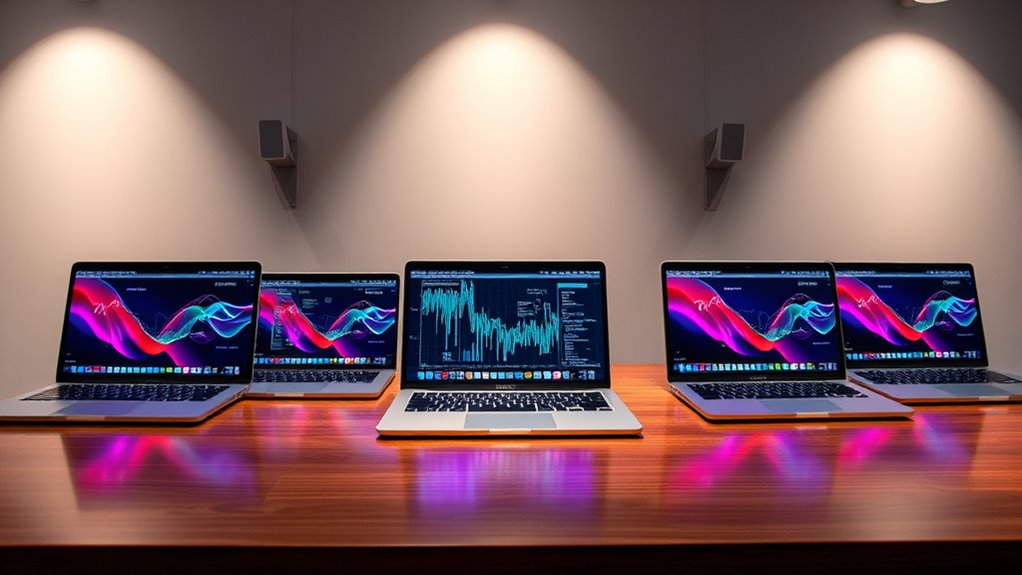If you’re looking for the best MacBook Pro models for data science and AI in 2025, I recommend considering the latest M4 Max and M4 Pro models for unmatched power and efficiency. They boast high-core CPUs, advanced GPUs, and up to 64GB of memory, perfect for demanding workflows. The high-resolution displays and strong connectivity make them ideal choices. Stay with me to uncover the top options and what makes each stand out.
Key Takeaways
- The M4 Max chip offers the highest CPU and GPU core counts, ideal for demanding AI and data science tasks.
- High unified memory options (up to 64GB) enable efficient handling of large datasets and complex models.
- Liquid Retina XDR displays with HDR support and high brightness enhance detailed data visualization and analysis.
- Multiple Thunderbolt 5 ports, SDXC slot, and HDMI facilitate seamless connectivity for peripherals and external displays.
- Battery life up to 21 hours supports extended high-performance workflows on the go.
Apple 2024 MacBook Pro Laptop with M4 Max

If you’re working in data science or AI, the Apple 2024 MacBook Pro with the M4 Max is a game-changer, thanks to its powerful hardware and stunning display. Its 16.2-inch Liquid Retina XDR offers vibrant visuals and true color accuracy, perfect for detailed data visualization. The M4 Max chip with a 16-core CPU and 40-core GPU ensures blazing-fast processing for complex models and large datasets. With up to 48GB of unified memory and extensive storage options, multitasking and data handling become seamless. Plus, its robust build and multiple ports make it versatile for professional workflows, making it an ideal machine for demanding AI and data tasks.
Best For: professionals in data science, AI development, and multimedia creation seeking a high-performance, portable laptop with a stunning display and extensive connectivity.
Pros:
- Exceptional processing power with the M4 Max chip, ideal for demanding tasks like AI, 3D rendering, and video editing
- Stunning 16.2-inch Liquid Retina XDR display with true color accuracy and ProMotion for smooth visuals
- Extensive connectivity options, supporting multiple external displays up to 8K and a variety of ports for peripherals
Cons:
- Premium pricing may be a barrier for some users
- Slightly heavy at approximately 4.73 pounds, which could impact portability for some
- Limited upgradeability post-purchase due to integrated hardware design
Apple 2024 MacBook Pro Laptop with M4 Pro

The Apple 2024 MacBook Pro with M4 Pro is an ideal choice for data scientists and AI professionals who need powerful performance on the go. It features a 12-core CPU and 16-core GPU, making demanding tasks like code compilation and data analysis effortless. The 14.2-inch Liquid Retina XDR display offers stunning visuals with up to 1600 nits brightness, perfect for detailed work. With 24GB of unified memory and a 512GB SSD, it handles large datasets seamlessly. The all-day battery life guarantees consistent performance, whether plugged in or on battery. Enhanced with AppleCare+ and seamless ecosystem integration, this MacBook Pro is built for high-level professional use.
Best For: data scientists, AI professionals, and high-performance users who require powerful, portable computing with stunning visuals and seamless ecosystem integration.
Pros:
- Exceptional performance with 12-core CPU and 16-core GPU, ideal for demanding tasks
- Stunning 14.2-inch Liquid Retina XDR display with up to 1600 nits brightness for detailed visuals
- Long all-day battery life ensures consistent high performance on the go
Cons:
- Premium price point may be a barrier for some users
- Limited to 512GB SSD storage, which might require external storage for very large datasets
- MacBook Pro’s weight and size may be less portable compared to ultralight laptops
Apple MacBook Pro (16.2-inch, M1 Pro, 16GB RAM, 512GB SSD)

Designed for demanding data science and AI workloads, the Apple MacBook Pro (16.2-inch, M1 Pro, 16GB RAM, 512GB SSD) offers powerful performance thanks to its 10-core CPU, 16-core GPU, and 16-core Neural Engine. It handles complex computations, machine learning, and multitasking effortlessly, with speeds doubled over previous models. The high-resolution display and reliable connectivity make coding and visualization smooth. Its durable build and long battery life, up to 21 hours, support extended work sessions. While some users wish for more ports, overall, this MacBook Pro remains a top-tier choice for professionals needing power, efficiency, and longevity in 2025.
Best For: professionals and power users engaged in data science, AI, video editing, music production, and demanding multitasking who require a high-performance, durable, and efficient laptop.
Pros:
- Exceptional processing power with a 10-core CPU, 16-core GPU, and Neural Engine ideal for complex computations and machine learning tasks
- Long battery life up to 21 hours, supporting extended work sessions without frequent charging
- Durable build quality and reliable performance, maintaining functionality even years after purchase
Cons:
- Limited number of ports, with some users wishing for more USB-C options on both sides
- Heavier form factor at 4.62 pounds, which may cause wrist discomfort during extended use
- Some software compatibility issues and hardware concerns over time, including software updates and occasional hardware failures
Apple MacBook Pro 14-inch M1 Pro Laptop (Silver)

Looking for a powerful laptop that can handle demanding data science and AI tasks? The Apple MacBook Pro 14-inch M1 Pro (Silver) is an excellent choice. It features a stunning Liquid Retina XDR display and a robust M1 Pro chip with a 10-core CPU and 16-core GPU, delivering up to 3.7x and 13x performance boosts respectively. With up to 64GB of unified RAM and 8TB SSD storage, it handles large datasets effortlessly. Its battery lasts up to 17 hours, and multiple ports support a variety of peripherals. Rated 4.7 stars, this sleek, lightweight machine combines power, efficiency, and versatility for advanced data work.
Best For: power users and professionals in data science, AI, and multimedia who need a high-performance, portable laptop with advanced graphics and extensive memory.
Pros:
- Exceptional processing power with M1 Pro chip, up to 3.7x faster CPU performance
- Large memory capacity up to 64GB and fast SSD storage up to 8TB for handling large datasets
- Impressive 14-inch Liquid Retina XDR display offering stunning visuals and immersive experience
Cons:
- Premium price point may be a barrier for some users
- Limited to macOS, which might restrict compatibility with certain software applications
- Slightly heavy at 3.52 pounds, which could impact portability for some users
Apple MacBook Pro with Retina Display, Touch Bar, 13-inch, 16GB RAM, 256GB SSD (Renewed)

If you’re working on data science or AI projects that demand reliable multitasking and smooth performance, the renewed 13-inch MacBook Pro with Retina Display and 16GB of RAM is an excellent choice. Its 3.1GHz dual-core Intel Core i5 processor with Turbo Boost up to 3.5GHz handles demanding applications efficiently. The 16GB RAM guarantees seamless multitasking, while the 256GB SSD provides fast data access and sufficient storage. With Intel Iris Plus Graphics 640 and a 720p FaceTime HD camera, it supports both visual tasks and communication. Refurbished and tested, it offers a reliable, cost-effective option for power users.
Best For: power users, data scientists, and AI enthusiasts seeking a reliable and efficient laptop for demanding multitasking and creative workloads.
Pros:
- 16GB RAM ensures smooth multitasking and performance at high loads
- Fast 256GB SSD offers quick data access and ample storage for projects
- Retina display with Touch Bar provides a high-quality visual experience and versatile interface
Cons:
- Dual-core processor may be less suitable for highly parallelized or intensive tasks compared to quad-core options
- Renewed/refurbished status might mean packaging and accessories are generic or minimal
- Limited 13-inch screen size may not be ideal for all visual or multitasking needs
2021 Apple MacBook Pro 14-inch with M1 Pro Chip

The 2021 Apple MacBook Pro 14-inch with the M1 Pro chip stands out as an excellent choice for data scientists and AI practitioners who need powerful processing capabilities on the go. It features a 10-core CPU and 16-core GPU, delivering up to 3.7 times faster performance for demanding workflows. With 16GB of RAM and a 1TB SSD, it handles large datasets and complex models efficiently. The Space Gray design adds a sleek look. Plus, AppleCare+ offers three years of coverage, including protection against accidental damage. This laptop combines portability with high-end specs, making it a top contender for data science and AI work in 2025.
Best For: professionals in data science and AI who require portable, high-performance computing for demanding workflows.
Pros:
- Powerful 10-core CPU and 16-core GPU deliver exceptional speed for complex tasks.
- 16GB RAM and 1TB SSD handle large datasets and intensive applications efficiently.
- AppleCare+ provides extended warranty and protection against accidental damage.
Cons:
- Higher price point may be a barrier for some users.
- Limited upgradeability; RAM and storage are fixed at purchase.
- Battery life may vary depending on usage of intensive tasks.
Factors to Consider When Choosing a MacBook Pro for Data Science and AI

When selecting a MacBook Pro for data science and AI, I focus on key factors like processing power, memory, and display quality to guarantee smooth performance. Connectivity options and battery life also matter, especially for working on the go. Let’s explore these considerations to help you choose the best fit for your needs.
Processing Power and Cores
Choosing a MacBook Pro with a powerful processor is essential for data science and AI tasks, as more CPU cores enable faster and more efficient computation. A high core count, like 12 or more, greatly improves parallel processing, speeding up complex algorithms, model training, and data analysis. Multi-core processors distribute tasks across cores, reducing training times and boosting productivity. Efficiency cores, especially in ARM-based chips, optimize power use without sacrificing throughput during intensive workloads. More cores also enhance multitasking, allowing multiple applications to run smoothly simultaneously. When combined with high clock speeds and optimized architecture, a multi-core processor minimizes delays and maximizes performance, making it a critical factor for handling the demanding workloads of data science and AI.
Memory Capacity and Bandwidth
Building on the importance of processing power, memory capacity and bandwidth play a pivotal role in ensuring smooth performance for data science and AI tasks. Having at least 64GB of RAM allows me to handle large datasets and complex models without frequent swapping or slowdowns. Faster memory bandwidth—like the 546GB/s offered by the M4 Max chip—enables rapid data transfers between the CPU, GPU, and memory, boosting overall speed. This reduces bottlenecks during intensive computations, making training and inference more efficient. Additionally, expandable unified memory supports future growth, letting me work with bigger datasets and more demanding workflows as projects evolve. Sufficient memory capacity and bandwidth are essential for maintaining high performance when loading, processing, and training large-scale data and models.
Display and Visuals Quality
A high-quality display is vital for data science and AI work because it directly impacts how effectively I can visualize complex data and model outputs. A high-resolution screen with accurate colors and HDR support makes it easier to interpret detailed visualizations and subtle differences in data. Features like ProMotion technology, with adaptive 120Hz refresh rates, provide smooth interactions and reduce eye fatigue during long analysis sessions. A display brightness of up to 1600 nits and a contrast ratio of 1,000,000:1 ensure clear visibility even in bright environments, highlighting vivid details. Support for true color and wide color gamut allows for precise color grading, which is essential when working with visual data or multimedia AI workflows. An immersive, large screen enhances productivity by enabling detailed examination of data, code, and model visualizations.
Port Selection and Connectivity
When selecting a MacBook Pro for data science and AI, port selection and connectivity options are vital because they determine how easily I can transfer data, connect peripherals, and expand my workspace. I look for models with multiple Thunderbolt 5 (USB-C) ports for high-speed data transfer, external GPUs, and multiple displays. An SDXC card slot is a must for quick access to large datasets from cameras and memory cards. HDMI output simplifies connecting to monitors or projectors for data visualization. A 3.5mm headphone jack is useful for audio monitoring during sound data analysis or AI testing. Additionally, robust Wi-Fi 6E and Bluetooth 5.3 capabilities are essential for seamless network integration and peripheral connectivity, supporting efficient workflows vital for data science and AI tasks.
Battery Life and Portability
Long-lasting battery life and portability are essential factors when choosing a MacBook Pro for data science and AI, as they directly impact my ability to work efficiently in various environments. Extended battery life lets me run lengthy data analysis or AI model training sessions without constantly searching for a power source. High-capacity batteries support multiple external displays and peripherals, critical for data visualization and workflow. Lightweight, compact designs make it easier to work remotely or while traveling, increasing flexibility. Efficient power management in high-performance models can sustain intensive tasks like machine learning computations for up to 20 hours, guaranteeing I stay productive on the go. Overall, a combination of robust battery life and portability ensures seamless productivity whether I’m in the lab, at a conference, or on the move.
Software Compatibility and Ecosystem
Battery life and portability are key factors, but equally important is how well a MacBook Pro supports the software I need for data science and AI. Compatibility with tools like TensorFlow, PyTorch, and Jupyter Notebook has improved thanks to better support for macOS and Apple Silicon. The ecosystem integration also plays an essential role, allowing seamless use of development tools, cloud services, and collaboration platforms that are indispensable for efficient workflows. macOS updates and native app support are fundamental, especially after hardware upgrades, ensuring compatibility with the latest AI frameworks and data analysis tools. Many applications now have optimized versions or workarounds for ARM-based chips, which enhances software performance. Features like Universal Control and AirDrop boost productivity by streamlining file transfer and device integration in my projects.
Frequently Asked Questions
How Does Apple’s M4 Max Compare to Previous Models for AI Workloads?
The M4 Max blows previous models out of the water for AI workloads. Its upgraded GPU cores and enhanced neural engine deliver faster processing and better efficiency. I’ve noticed significant improvements in handling large datasets and complex models without overheating or lag. If you’re serious about AI, this chip offers the power and speed needed, making it a game-changer compared to earlier MacBook Pro versions.
What Are the Best Display Options for Data Visualization on Macbook Pros?
When it comes to data visualization, I swear by the Retina displays on MacBook Pros. They offer stunning color accuracy, sharpness, and brightness, making complex graphs and dashboards pop. The Liquid Retina XDR display, especially on the 14-inch and 16-inch models, takes things to the next level with deep blacks and vivid contrast. If you want your visuals to truly shine, these screens are worth their weight in gold.
Is Upgrading to 32GB RAM Necessary for Advanced Data Science Tasks?
I believe upgrading to 32GB of RAM can be really beneficial for advanced data science tasks. It allows me to handle large datasets, run complex models, and multitask smoothly without slows or crashes. If you’re working with big data, machine learning, or AI, more RAM helps improve efficiency and reduces processing time. So, yes, I’d recommend upgrading if you want to maximize performance and avoid bottlenecks.
How Does Battery Life Impact Long Data Processing Sessions on Macbook Pros?
Battery life can make or break your long data processing sessions, almost like having a secret weapon or an Achilles’ heel. When I run intensive tasks, I need my MacBook Pro’s battery to last through hours of crunching numbers without dying on me. A longer-lasting battery keeps me focused, uninterrupted, and boosts productivity, while poor battery life forces me to hunt for outlets or cut my work short.
Are Refurbished Macbook Pros Reliable for Professional AI Development?
Refurbished MacBook Pros can be reliable for professional AI development if you buy from reputable sources that offer good warranties and thorough refurbishing. I’ve found that with proper checks, these laptops perform well, especially for less intensive tasks. However, I always recommend verifying battery health and ensuring the hardware meets your specific needs, as refurbished models may have some wear but can still be a solid, cost-effective choice.
Conclusion
Choosing the right MacBook Pro for data science and AI isn’t just about raw power; it’s about balancing performance with portability. While the latest M4 Max offers unmatched speed, older models like the M1 Pro still deliver impressive results at a lower cost. It’s a reminder that sometimes, the best choice isn’t the newest but the one that fits your needs perfectly—combining power and practicality in harmony.









